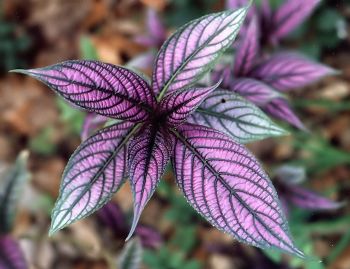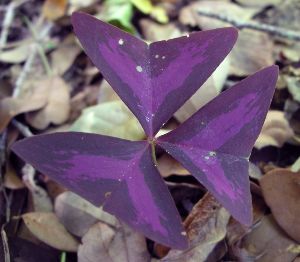Purple Plants
by Valerie (June 30, 2000)
revised November 10, 2003
 One of our gardens is in the shade of two huge live oak trees. Since this garden is always shaded, a lot of flowering plants don't do well. When I was little, my favorite color was purple, and I'm still very fond of it, so, to add color, I've planted several plants with purple foliage which, in the fall, compliment a large beautyberry bush that produces purple berries.
A common landscape plant in this area is the purple heart (Tradescantia pallida). It is a member of the spiderwort genus but has very tiny flowers and much showier leaves. The plant does best with more sun (too much tends to burn it though), but is tolerant of shade as well and certainly can take the drought conditions. It is a large, creeping plant that makes a good groundcover and is freeze-tolerant.
Oxalis is usually a green plant, but the purple version (Oxalis regnelli) is a striking variation with its two-inch wide sharply-triangular leaves. The plant blooms off and on during the growing season, but with only a few small pink flowers at a time. We have a tiny clump located near a large bucket of water that we always keep filled for wildlife, so it gets the extra water it needs to keep growing. If it is allowed to dry out it will simply go dormant. Like most oxalis species, this one sends out leaves during wet weather, and they die off during dry. It is especially sensitive to very hot temperatures and does much better when it is cooler. |

